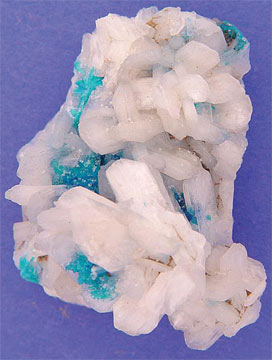|
NEWS NOTES
Mineral resource of the month: natural and synthetic zeolites
| Cavansite is the bluish mineral on the stilbite matrix. Both are zeolite minerals. |
Robert Virta, mineral commodity specialist for the U.S. Geological Survey, prepared the following information about the zeolite industry. Volcanic rocks containing natural zeolites — hydrated aluminosilicate minerals that contain alkaline and alkaline-earth metals — have been mined worldwide for more than 1,000 years for use as cements and building stone. For centuries, people thought natural zeolites occurred only in small amounts inside cavities of volcanic rock. But in the 1950s and early 1960s, large zeolite deposits were discovered in volcanic tuffs in the western United States and in marine tuffs in Italy and Japan. And since then, similar deposits have been found around the world, from Hungary to Cuba to New Zealand. The discovery of these larger deposits made commercial mining of natural zeolite possible.
Zeolites are most useful commercially because of their unique crystal structure, which allows them to act as molecular sieves — selectively sorting molecules based on particle sizes — that adsorb gases and liquids. For example, zeolites are used in the United States in pet litter, animal feed, horticulture (fertilizers and soil additives), laundry detergent and water purification. Zeolite-containing volcanic tuffs are also still mined to use as dimension stone, lightweight aggregate and in cement.
More than 40 natural zeolites have been identified during the past 200 years. Zeolites are distinguished by differences in their chemical compositions and the size and arrangement of their crystal structures. Clinoptilolite is the most commonly mined natural zeolite, followed by chabazite and mordenite.
During most of the 20th century, especially before larger deposits of zeolite-containing rocks were discovered, most commercial applications used synthetic zeolite. Zeolites were first synthesized in the 1930s, but the synthetic zeolite market did not materialize until the 1960s, when their large-scale use for catalytic cracking in petroleum refining began. The value of synthetic zeolites to the petroleum industry was so great that researchers synthesized more than 150 zeolites in an effort to discover new, more efficient catalysts. In the 1970s, demand spiked again when synthetic zeolites began to replace phosphate compounds in laundry detergent powders. Current world production of synthetic zeolites is estimated to be about 1.4 million metric tons per year. Almost 80 percent of synthetic zeolites are used in laundry detergent. More recently, the U.S. military has been using synthetic zeolites as a hemostatic agent to promote clotting of traumatic wounds. Additionally, copper- and silver-exchanged synthetic zeolites are being used as antimicrobial agents in dust masks, plastic films and paints, and in antifouling paints used to control barnacle growth on boats.
There is little competition between natural zeolites and synthetic zeolites. The high cost of synthetic zeolites precludes their use for most natural zeolite applications. Conversely, stringent product specifications prevent the large-scale use of natural zeolites for most synthetic zeolite applications.
For more information on zeolites and other mineral resources, visit: minerals.usgs.gov/minerals.
Links:
Earth Science World Image Bank

 Subscribe
Subscribe



